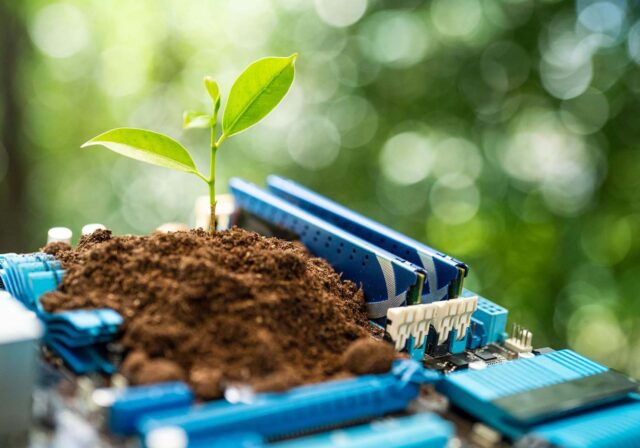Electronics recycling isn’t just about cleaning up your home - it’s an easy yet powerful way to help protect our communities and the planet. In this guide, we’ll break down what e-waste is, common types, why recycling e-waste matters, and how you can recycle electronics safely, quickly, and easily.
What is e-waste?
E-waste, also known as electronic waste, is anything with an electrical or electronic component that you no longer use, or that’s broken, outdated, or just taking up space. E-waste could be an old phone, a broken laptop, or even that toaster oven you haven’t turned on in years.
A key component of e-waste is that it may contain valuable materials that can be reused or recycled. It may also have harmful materials that make throwing it away not only wasteful, but possibly toxic.
What is considered e-waste? 7 Common types:
- Small electronics: Phones, tablets, cameras, headphones, anything portable and electronic.
- Large appliances: Think refrigerators, washing machines, and other bulky household items.
- Computers & accessories: Desktops, laptops, monitors, printers, hard drives, keyboards, and all the tech you use for work or play.
- TVs & monitors: Including both flat-screen models and older CRT (the boxy ones) TVs.
- Kitchen appliances: Microwaves, toasters, blenders, rice cookers, pressure cookers, etc.
- Lighting devices: LED bulbs, fluorescent tubes, and other lighting tech.
- Batteries: Single-use and rechargeable, from everything to phones and cameras to laptops.
4 reasons why electronics recycling is important
If you’re wondering why you should care about recycling e-waste, the answer lies in the impact it has on both the environment and resources. Here are four reasons:
- Environmental impact: E-waste only makes up about 2% of landfill waste but accounts for 70% of its toxic waste. If you toss your old electronics in the trash, they end up in landfills, where toxic chemicals like mercury, lead, and cadmium can leak into the soil and water.
- Resource conservation: Inside your electronics are valuable materials like gold, silver, and copper, not to mention rare earth elements that are used in things like smartphones. Recycling means we don’t have to mine more of these precious resources, so it’s a win for the environment and for future generations.
- Energy savings: Manufacturing new electronics takes a lot of energy, but recycling uses much less energy and produces fewer greenhouse gases. So, by recycling, you help conserve energy and reduce pollution.
- Economic and social benefits: E-waste recycling creates jobs and supports a circular economy, where materials are reused and products are designed to last longer.
4 challenges and complexities in electronics recycling
While e-waste disposal isn’t complex for the person looking to recycle, getting communities, cities, states, and even countries on board can make it more challenging. Here’s why:
- Complex materials: Electronic devices are made from a mix of materials, some of which are hazardous. Trying to recycle all these materials properly requires specialized equipment and processes.
- Informal electronics recycling: In some parts of the world, e-waste is recycled informally in unsafe conditions. This can lead to serious environmental and health issues because harmful substances like mercury or lead aren’t dealt with correctly.
- Awareness & participation: A lot of people still don’t know how to recycle e-waste properly, or they don’t realize how important it is. Awareness is a huge barrier.
- Inconsistent infrastructure: Depending on where you live, the availability of local e-waste recycling programs can vary. It’s not always clear where to take your old gadgets for safe recycling.
The electronics recycling process: Step by step
Recycling e-waste is a process that’s done in several steps to ensure that materials are recovered and harmful substances are handled safely. Here’s a closer look at how recycling e-waste works:
- Collection: Your e-waste can be dropped off at collection points, local recycling centers, or through retailer take-back programs. It’s important to separate things like batteries before dropping them off.
- Safe storage: E-waste that contains hazardous materials, like old TVs or monitors with lead, should be stored safely to prevent leaks or contamination.
- Sorting, dismantling, and shredding: The devices are taken apart manually to remove any hazardous or reusable parts. The remaining electronics are shredded into small pieces to make the recycling process easier.
- Mechanical separation: Various types of materials, like metals, plastics, and glass, are separated using magnets or other methods.
- Material recovery: After the materials are separated, they’re cleaned and prepared for reuse. Metals are melted down, plastics are recycled into new products, and glass can be used again in other applications.
5 common materials extracted from e-waste and their uses
When you recycle e-waste, you’re helping to recover materials that can be used again in new products. Here are five things that can be pulled from e-waste:
- Metals: Gold, silver, copper, and even platinum can be extracted and reused.
- Rare earth elements: Neodymium and dysprosium, critical for modern tech, can be recovered.
- Plastics: Recycled plastics can be used in new products.
- Glass: Glass from CRT monitors gets recycled for new glass products.
- Other components: Motors, circuit boards, batteries, and even LCD screens can be recycled.
Special processes for common e-waste items
Some e-waste items require extra care during recycling:
- Batteries: Different types of batteries require different recycling processes. They need to be sorted to prevent leaks and to recover valuable metals.
- CRTs (cathode ray tubes): These old-school monitors and TVs contain lead, which must be safely removed and recycled.
- Computers and laptops: Data destruction is a priority, and many parts can be reused or recycled.
- Mobile phones and tablets: Phones and tablets are packed with precious metals and must be carefully disassembled to recover those valuable materials.
How to recycle e-waste: 2 stages
- Before recycling:
- Upgrade or repair: If your device is still in good condition, think about fixing it or upgrading instead of recycling it.
- Erase data: Make sure to back up your files and securely erase personal data before recycling. This means performing a factory reset on your phone, laptop, or tablet. Most phones and computers have built-in features to wipe everything securely, so be sure to use those.
- Remove batteries: If your devices have removable batteries, always take them out and dispose of them separately.
- Finding a recycling location:
- Local centers: Check for community drop-off points or e-waste collection centers. Your city may also participate in free e-waste or household hazardous waste collection days.
- Retail take-back programs: Many stores like Best Buy and Staples will take some of your old gadgets for free.
- Cellular providers: Some cellular providers like T-Mobile offer trade-in programs that let you swap an eligible phone for credit toward a new one. Even if your phone isn’t eligible for a trade-in deal, you can still bring your device (any make, model, or carrier) to a store near you and get it recycled for free. They also take batteries, tablets, and netbooks.
- Online locators: Websites like Earth911, Greener Gadgets, and Call2Recycle can help you find a recycling center near you.
Donating and reusing electronics
Before recycling electronics, consider donating the items if they’re still in good shape. There are plenty of organizations and charities that are happy to take your old devices, and it’s a great way to give them a second life. Donating electronics not only reduces waste but also helps someone else in need, making it a win-win.
Regulations, certifications, and responsible recycling
When you recycle electronics, it’s important to make sure it’s going to a responsible recycler. Look for certifications like R2, which ensure that e-waste is handled safely. These standards protect both the environment and the people involved in the recycling process. You can find an R2 certified facility near you by clicking here. T-Mobile only uses R2 certified suppliers for repair and recycling of devices.
The future of electronics recycling
The future of e-waste disposal looks bright, with new technologies making it easier to extract materials and recycle electronics more efficiently. As manufacturers design products that are easier to recycle, we’ll be one step closer to a world where e-waste is minimized, and the circular economy thrives.
So, take a few extra steps to recycle your old electronics properly and help keep your home, and the planet, clutter-free.
Want more tips you can use? You may be interested in:
- 5 Next-Level Security Wi-Fi Tips for Home
- 10 Tips for Faster Internet Speeds
- How to Set Up A Guest Wi-Fi Network
- Why Your Wi-Fi is Slow and How to Fix It
Sources:
https://alianzarecycling.com/resources/e-waste-statistics
https://www.who.int/news-room/fact-sheets/detail/electronic-waste-(e-waste)
https://www.conceptmanagement.co.uk/knowledge/materials/precious-metal/
https://www.epa.gov/mercury/mercury-consumer-products
https://www.epa.gov/large-scale-residential-demolition/electronic-waste-and-demolition
https://earth.org/what-is-e-waste-recycling/
https://www.ewaste1.com/is-it-illegal-to-throw-away-electronics
https://millerrecycling.com/electronics-recycling-what-you-can-and-cant-recycle-it-matters/
https://sustainableelectronics.org/find-an-r2-certified-facility/
https://www.azom.com/article.aspx?ArticleID=24337
https://www.ecospotrecycling.com/how-e-waste-recycling-creates-jobs-and-drives-the-circular-economy/
https://ntrecycling.com/states-with-e-waste-laws/
https://sell.amazon.com/programs/renewed
https://www.staples.com/stores/recycling
https://www.bestbuy.com/site/services/recycling/pcmcat149900050025.c
https://www.homedepot.com/c/ab/how-to-dispose-of-batteries/9ba683603be9fa5395fab90124a115f1



